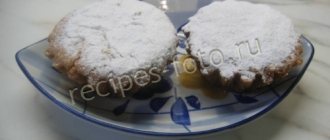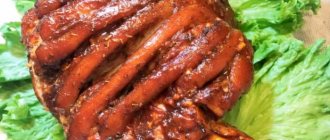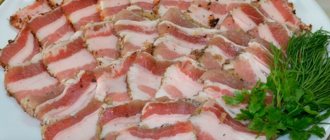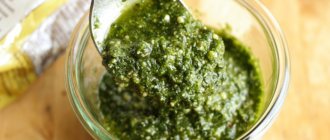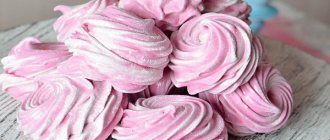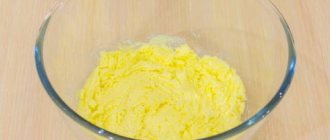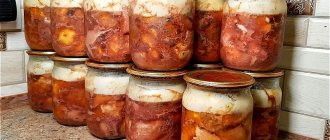8
Updated: Arina Volskaya
05/27/2014 Cooking time: 1 hour 30 minutes
| Save | I cooked) | Estimate |
Tasty and crispy sweet baklava - remember how food peddlers shout on the beaches of Crimea? Let's prepare this sweetness for tea and give ourselves memories of our summer vacation.
Baklava “Crimean” honey
For the test:
For the syrup:
Today I’m preparing “Crimean” baklava.
If you have ever been to Crimea, then you probably know it, since in Crimea such baklava is sold literally everywhere. And even on the beach, vendors wear huge nets. Baklava is really very tasty, tender, fragile-crumbly, honey-like. Of course, it’s insanely high in calories, but very tasty. Let's cook! PREPARATION:
A short preface. Choose refined, deodorized vegetable oil, i.e. tasteless and odorless. I often came across baklava recipes where a little vodka was added to the dough to make the baklava even more crumbly and bubbly. If you don't mind vodka in the dough, then add 1-2 tablespoons. The dough actually turns out a little different and the baklava turns out more crumbly and bubbly. I won't add vodka. I know that many people are wary of ready-made baking powder, and if you are one of them, then you can safely skip the baking powder in this recipe. Just prepare the dough without baking powder, no need to replace it with anything.
Mix the flour and baking powder, do it thoroughly so that the baking powder is evenly distributed throughout the entire volume, and then sift.
I will knead the dough in a kitchen machine, but you can knead it completely by hand. The kneading sequence will be absolutely the same. Pour milk into the bowl of the kitchen machine, add sour cream, melted butter, add salt, install the hook attachment and, gradually adding flour, knead a smooth, homogeneous and fairly stiff dough.
The dough is plastic, elastic, absolutely non-sticky.
It cuts well with a knife, the cut is homogeneous, and at the same time the dough does not stretch behind the knife blade; it can be cut quite easily even into small pieces.
Round the dough, put it in a bowl, cover and leave on the work table for 15-20 minutes. During this time, the flour gluten in the dough will relax, it will become much softer, more pliable, and it will be easier to roll out. I draw your attention to the fact that the dough for baklava should be steep, it should be denser and steeper than the traditional dough for dumplings and dumplings, much like the dough for homemade noodles. Only hard dough can be rolled out thinly and it will not tear, and when cutting it will not stick together. And if you don’t roll out the dough thinly, then the baklava won’t turn out the way it should be. On thickly rolled out dough, baklava will be quite rough, but if you roll out the dough thinly, then the baklava will be tender and crumbly.
I divide the dough into 4 parts because I will be rolling out large sheets of dough.
But, as an option, the dough can be divided into more parts. This will make the dough pieces smaller and may make it easier for you to roll them out. We round each piece of dough by bringing the edges of the dough towards the center.
And roll it up to form a smooth ball. Cover the rolled pieces of dough and leave for another 5-7 minutes to rest.
I will roll out the dough into a large layer, I will roll it out with a long rolling pin. If you don’t have such a rolling pin or it’s inconvenient for you to roll out such large pieces of dough, then you can absolutely easily divide the dough into smaller pieces - into 6, 8, 12 parts and roll out these small pieces with a regular rolling pin. This is completely acceptable, there is no difference.
Next we will need to roll out the dough very thin.
The thinner the dough is rolled out, the tastier and more tender the baklava. It is desirable that the rolling thickness be about 1 mm. When rolling, if the dough sticks to the rolling pin, use flour, but just keep in mind the fact that we will deep-fry the baklava, so use flour very sparingly, only as needed. As you can see, through the thinly rolled dough you can quite easily see the design on the packaging.
Before slicing, we need to dry the dough slightly. Dust the dough with flour, roll it onto a rolling pin, turn it over using a rolling pin, dust it with flour on the other side, roll the dough onto the rolling pin again and transfer it to the laid out sheet. There we level the dough and leave it for 10-15 minutes so that it airs and dries slightly. While the dough is drying, we will have time to roll out all the remaining pieces. Before cutting, the dough must be allowed to air, dry slightly, because if this is not done, if you fold the dough and cut it immediately after we have rolled it out, then when cutting the dough will stick together, and as a result the baklava will not turn out as flaky as it should be. But at the same time, make sure that your dough does not dry out, because if it is too dry, it will break and crumble when folded. Place the dough on the work surface, shake off the remaining flour and loosely roll it into a flat roll.
Baklava: what is it, what is it made from?
Baklava (baklava) is a dessert made from puff pastry, nuts, and the addition of sugar or honey syrup. The history of the sweet dish is not well documented. There is evidence that the Sultan of the Tolkapı Palace presented trays of baklava to the Janissaries every 15th of the month of Ramadan during a solemn procession.
The product is made from filo - yeast-free thin (less than 1 mm) dough, each layer is coated with butter. The layers are generously sprinkled with chopped nuts, usually walnuts. But pistachios, hazelnuts, and almonds are also used in recipes. In a number of products, only the top is sprinkled with nuts.
The product is baked at 180°C for 30 minutes, after cutting into diamond-shaped or rectangular pieces. The finished baked goods are poured with syrup made from granulated sugar, honey, rose or orange water. The filling should soak the dessert well.
In Turkey, in the Aegean region, the product is prepared with walnuts and almonds, in the Black Sea region - with hazelnuts. In a light version of baklava, the famous Turkish dessert Sütlü Nuriye, the syrup is replaced with milk.
Compound:
Milk dough:
- 250 ml milk
- 60 g butter
- 50 ml sour cream
- 1/4 teaspoon baking soda
- 3.5-4 cups flour
Soda water dough:
- 250 ml sparkling water
- 1 teaspoon sugar
- a pinch of salt
- about 3 cups flour
Syrup:
- 500 g sugar
- 200 ml water
- 2 teaspoons honey (optional)
And:
- some roasted walnuts
- 500 ml refined vegetable oil
How to cook baklava at home: 8 delicious and simple recipes
Every Turkish confectionery store offers a huge variety of baklava varieties. Most of the recipes are not complicated and the housewife can easily prepare the dessert at home.
Turkish baklava
Add a glass of warm milk, 250 g of melted butter, and an egg to the sifted flour (0.5 kg). Make the dough and put it in the cold. Divide into 20 parts, roll out strips.
For the filling: walnuts (250 g) are ground with powdered sugar (300 g). Stripes are sprinkled on it and rolls are rolled. Place in a baking dish and coat with yolk. Cook in the oven at 160°C for 50 minutes. The baklava is soaked in the filling.
Description of preparation:
Crispy beach sweetness that makes you feel so good swimming in the sea.
Beauty and deliciousness! I suggest trying a simple recipe for Crimean baklava. According to this recipe, it will taste almost the same as on a warm Crimean beach. Of course, to fully feel like you are in Crimea, the warm sun and golden sand are not enough, but you can take an album with photos and plunge into a happy vacation time. So, a recipe for Crimean baklava with a photo - let's go to the kitchen and cook! Purpose: For children / For the holiday table Main ingredient: Nuts / Dough Dish: Baking / Desserts / Baklava Geography of cuisine: Russian cuisine
A simple recipe for pakhvala with nuts
Prepare:
Cooking
1 First, combine baking soda with flour. Stir well. Then grate the margarine on a coarse grater into a bowl with flour and soda. It is better to pre-freeze margarine by placing it in the freezer for 20 minutes. In this case, the margarine will rub better.
2 Using a fork, stir the margarine and flour well, turning it into an oily mass. Make a hole in the middle of the bowl and pour in 4 yolks and a glass of sour cream. Mixes everything well.
3 Knead the dough first with a fork and then with your hands. It is better to place it on a silicone mat or cutting board to make it easier to knead. The dough should be dense and smooth. Place in the refrigerator for an hour.
4 Meanwhile, grind the nuts using a blender. You should end up with a not-so-fine crumb. Nuts should be ground into small pieces.
5 Beat the egg whites using a mixer, gradually adding sugar. Add sugar in small portions, allowing it to completely dissolve. Van's protein-sugar mixture will not be perfectly whipped because there is a lot of sugar. It will turn out liquid. And pour it into the nuts. Stir well.
6 Divide the frozen dough into three parts, since we will have three cake layers. Roll out each part into a thin crust. When rolling out the dough, place it in the shape in which you will bake it. In our case, this is the shape of a square baking sheet.
7 Transfer the resulting cake to a baking sheet. We cut off the excess. Don't forget to make sides so that the bottom layer of nuts doesn't spread.
8 Place half of our protein-nut mixture on the bottom layer. And distribute evenly over the entire surface of the cake using a spatula.
9 Roll out the next part of the dough into the same shape as the previous one. Also shaping the baking sheet. Cover the first layer of filling with it and remove the excess.
How to prepare Turkish baklava at home?
Turkish baklava is a national version of a traditional dessert, consisting of many thin layers of dough baked in oil, soaked in sugar syrup and crushed pistachios.
Cooking time: 50 minutes.
Cooking time: 15 min.
Calorie content of foods possible in the dish
- Honey – 400 kcal/100g
- Walnut oil – 925 kcal/100g
- Walnuts – 650 kcal/100g
- Black English walnut – 628 kcal/100g
- Black Persian walnut – 651 kcal/100g
- Flour – 325 kcal/100g
- Fortified whole durum wheat flour – 333 kcal/100g
- All-purpose whole durum wheat flour – 364 kcal/100g
- Coarse flour – 348 kcal/100g
- Sugar - 398 kcal/100g
- Granulated sugar - 398 kcal/100g
- Vegetable oil – 873 kcal/100g
- Cognac – 239 kcal/100g
- Ordinary cognac “three stars” – 239 kcal/100g
- Salt – 0 kcal/100g
- Water – 0 kcal/100g
- Mineral water – 0 kcal/100g
- Powdered sugar - 374 kcal/100g
Calorie content of foods: Flour, Mineral water, Cognac, Sugar, Salt, Water, Honey, Walnuts, Powdered sugar, Vegetable oil


